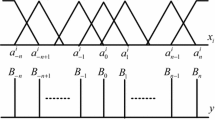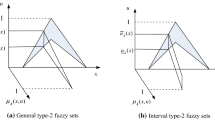Abstract
As is well known, Zadeh presented the compositional rule of inference to discuss complex inference modes. After that other researchers also investigated this problem. However, the classic fuzzy control systems in the application often encounter the curse of dimensionality. To overcome these difficulties in the classic fuzzy control systems with high-dimensional input variables, the entire triple-I algorithm for double fuzzy control systems and manifold learning of dimensionality reduction will be discussed in this paper. Specifically, triple-I FMP algorithm is presented for double hierarchical fuzzy control system based on Guojun Wang’s implication operator and its reversibility is proved. Using manifold learning, dimension reduction SNE algorithm is given for double-layer hierarchical fuzzy control systems to keep the distribution of peak possibly point, so as to minimize the control stability impact due to reducing dimension. Since any type of multi-layer fuzzy control system is regarded as multiple fusion of double-layer hierarchical fuzzy system, the proposed algorithms and their reversibility are universal.



Similar content being viewed by others
Explore related subjects
Discover the latest articles and news from researchers in related subjects, suggested using machine learning.References
Chen CS, Chen WL (1998) Robust adaptive sliding-mode control using fuzzy modeling for an inverted pendulum system. IEEE Trans Ind Electron 45(2):297–306
Chen CLP, Liu ZL (2018) Broad learning system: an effective and efficient incremental learning system without the need for deep architecture. IEEE Trans Neural Netw Learn Syst 29(1):10–24
Gong M, Zhao J, Liu J, Miao Q, Jiao L (2016) Change detection in synthetic aperture radar images based on deep neural networks. IEEE Trans Neural Netw Learn Syst 27(1):125–138
Hinton G, Roweis S (2002) Stochastic neighbor embedding. Adv Neural Inf Process Syst 41(4):833–840
Joo MG, Lee JS (2005) A class of hierarchical fuzzy systems with constraints on the fuzzy rules. IEEE Trans Fuzzy Syst 13(2):194–203
Li HL, Liu DR, Wang D (2018) Manifold regularized reinforcement learning. IEEE Trans Neural Netw Learn Syst 29(4):932–943
Li JH, Mei CL, Lv YJ (2013) Incomplete decision contexts: approximate concept construction, rule acquisition and knowledge reduction. Int J Approx Reason 54(1):149–165
Li HX, Miao ZH, Wang JY (2002) Variable universe adaptive fuzzy control on the quadruple inverted pendulum. Sci China Ser E (Technol Sci 45(2):213–224
Li KW, Shao MW, Wu WZ (2017) A data reduction method in formal fuzzy contexts. Int J Mach Learn Cybern 8(4):1145–1155
Liu PY, Li HX (2005) Approximation of stochastic processes by TCS fuzzy systems. Fuzzy Sets Syst 155(2):215–235
Mamdani EH (1977) Application of fuzzy logic to approximate reasoning using linguistic systems. IEEE Trans Comput 26(12):1182–1191
Pei DW (2008) Unified full implication algorithms of fuzzy reasoning. Inf Sci 178(2):520–530
Raju GVS, Jun Z (1993) Adaptive hierarchical fuzzy controller. IEEE Trans Syst Man Cybern 23(4):973–980
Shao MW, Li KW (2017) Attribute reduction in generalized one-sided formal contexts. Inf Sci 378:317–327
Song SJ, Feng CB, Lee ES (2002) Triple I method of fuzzy reasoning. Comput Math Appl 44(12):1567–1579
Wang CZ, Hu QH, Wang XZ, Chen DG, Qian YH, Dong Z (2018) Feature selection based on neighborhood discrimination index. IEEE Trans Neural Netw Learn Syst 29(7):2986–2999
Wang GJ (1999) Full implication triple I algorithm for fuzzy reasoning. Sci China Ser E (Technol Sci) 29(1):43–53 (in Chinese)
Wang GJ (2000) Triple I method and interval value for fuzzy reasoning. Sci China Ser E (Technol Sci) 40(3):242–253 (in Chinese)
Wang GJ, Duan CX (2012) Generalized hierarchical hybrid fuzzy system and its universal approximation. Control Theory Appl 29(5):673–680 (in Chinese)
Wang LX (1998) Universal approximation by hierarchical fuzzy system. Fuzzy Sets Syst 93(2):223–230
Wang LX (1999) Analysis and design of hierarchical fuzzy systems. IEEE Int Trans Fuzzy Syst 7(5):617–624
Xiang SM, Nie FP, Zhang CS, Zhang CX (2009) Nonlinear dimensionality reduction with local spline embedding. IEEE Trans Knowl Data Eng 21(9):1285–1298
Yin JS, Xiao J, Zhou ZT, Hu DW (2007) Method of nonliner manifold learning and its application. Progress Nat Sci 17(8):1015–1025
Zadeh LA (1973) Outline of a new approach to the analysis of complex systems and decision processes. IEEE Trans Syst Man Cybern 3(1):28–33
Zhang JP, Chen DW, Kruger U (2008) Adaptive constraint K-segment principal curves for intelligent transportation system. IEEE Trans Intell Transp Syst 9(4):666–677
Zhang J, Ding SF, Zhang N, Shi ZZ (2016) Incremental extreme learning machine based on deep feature embedded. Int J Mach Learn Cybern 7(1):111–120
Zhang X, Mei CL, Chen DG, Li JH (2016) Feature selection in mixed data: a method using a novel fuzzy rough set-based information entropy. Pattern Recognit 56:1–15
Zhao YX, Li JH, Liu WQ, Xu WH (2017) Cognitive concept learning from incomplete information. Int J Mach Learn Cybern 8(1):159–170
Zhao SY, Chen H, Li CP, Du XY, Sun H (2015) A novel approach to building a robust fuzzy rough classifier. IEEE Trans Fuzzy Syst 23(4):769–786
Zhao Z, Feng GC, Zhu JH, Shen Q (2016) Manifold learning: dimensionality reduction and high dimensional data reconstruction via dictionary learning. Neurocomputing 216:268–285
Zhu XD, Wang J (2013) A new type of hierarchical fuzzy system and its approximation performance. Control Decis 28(10):1559–1563, 1567 (in Chinese)
Acknowledgements
This work was supported by the National Natural Science Foundation of China (nos. 61573173 and 61562050).
Author information
Authors and Affiliations
Corresponding author
Additional information
Publisher's Note
Springer Nature remains neutral with regard to jurisdictional claims in published maps and institutional affiliations.
Rights and permissions
About this article
Cite this article
Li, M., Liu, W. Triple-I FMP algorithm for double hierarchical fuzzy system based on manifold learning. Int. J. Mach. Learn. & Cyber. 10, 2459–2466 (2019). https://doi.org/10.1007/s13042-018-0882-x
Received:
Accepted:
Published:
Issue Date:
DOI: https://doi.org/10.1007/s13042-018-0882-x




